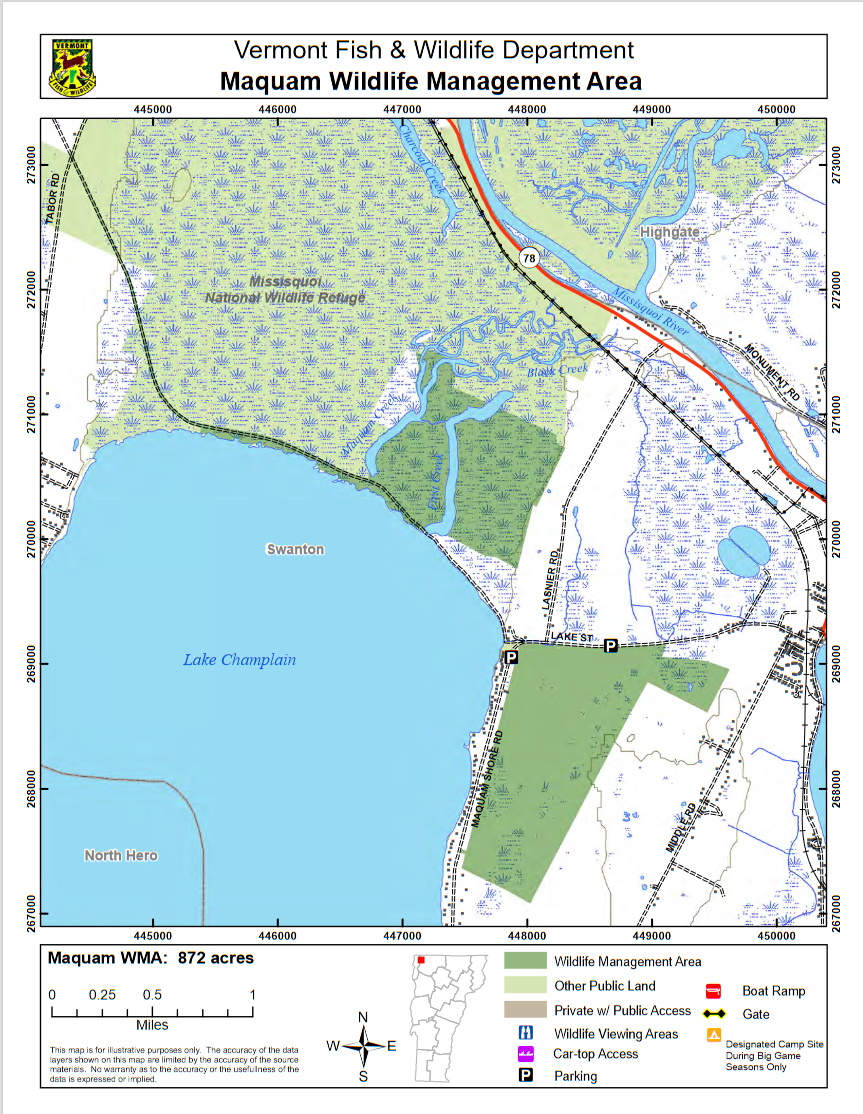Maquam WMA / Swanton Town Beach
Maquam WMA / Swanton Town Beach
Swanton, Vermont 05488
Maquam Wildlife Management Area guide and mapSteve Lamonde's Bird Observer article: Searching for Gold
Birds of Interest
There is excellent birding in the Maquam Wildlife Management Area. Look especially for marsh and wading birds, shorebirds, and waterfowl. Missisquoi NWR has one of the largest great blue heron rookeries in Vermont; consequently one may commonly see these herons in Maquam. The WMA is a popular waterfowl hunting area. Upland game birds include ruffed grouse, American woodcock, and common snipe. There are several raptors on the WMA, including northern harriers, Cooper’s and sharp-shinned hawks, great horned, barred, and screech owls. Ospreys nest and bald eagles are present at Missisquoi NWR and may be seen at Maquam. There is also good birding for songbirds including eastern kingbirds, great crested flycatchers, alder flycatchers, cedar waxwings, wood thrushes, veery, scarlet tanagers, Baltimore orioles, and several warbler species.
About this Location
Maquam Wildlife Management Area (WMA) is located in the town of Swanton in northwestern Vermont. It consists of 872 acres, some of which are south of VT-36 west of town. The remainder is along the lakeshore northwest of VT-36. The land is owned by the State of Vermont and managed by the Vermont Fish and Wildlife Department.
Maquam WMA is located in the Champlain Valley and has both upland and wetland environments. First Creek and Maquam Creek are slow-moving streams at lake level. The WMA is adjacent to the Missisquoi National Wildlife Refuge (NWR), which includes an extensive delta. Together, the WMA and NWR conserve the largest wetland complex on Lake Champlain. The Lampman parcel acts as an important travel corridor for wildlife moving to and from Missisquoi NWR.
The wetland portions of the WMA have several different components. Besides open water, there are deep broad-leaf, wild rice, and cattail marshes. There are some shrub swamps, including a rather unusual sweet gale shoreline swamp. There are buttonbush swamps and red or
silver maple-green ash swamps. Some ancient sand dune ridges rise above the surrounding wetlands and support black gum at the northern edge of its range. Winterberry, leatherleaf, and red-osier dogwood also grow on the dune ridges. The upland habitats include a lakeside floodplain forest and maple-ash-hickory-oak forest. Because part of the WMA used to be farm fields, some of the forest is early successional, growing such trees as eastern cottonwood and aspen and willow species.
There are several rare and endangered species present on Maquam WMA. Small beggar’s tick, yellow water-crowfoot, small bidens, and Virginia chain-fern are herbaceous plant species that occur. Endangered ospreys, bald eagles, and black terns all occur in nearby Missisquoi NWR and are sometimes seen in the WMA. It is against the law to disturb any threatened or endangered species, either plant or animal. Please use binoculars and keep your distance.
Features
Restrooms on site
Wheelchair accessible trail
Entrance fee
Content from Maquam Wildlife Management Area guide and map
Last updated January 21, 2024
